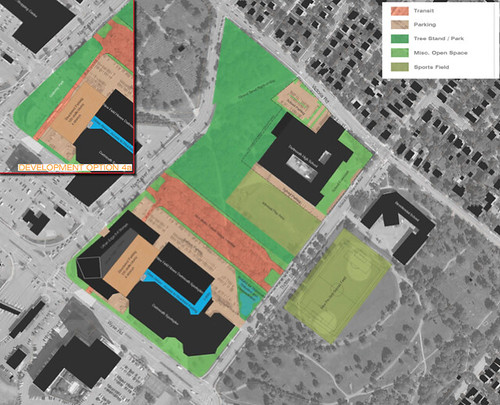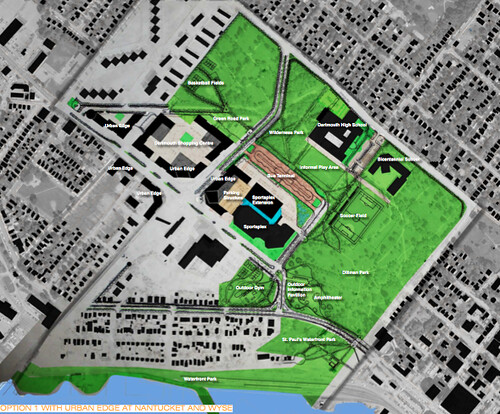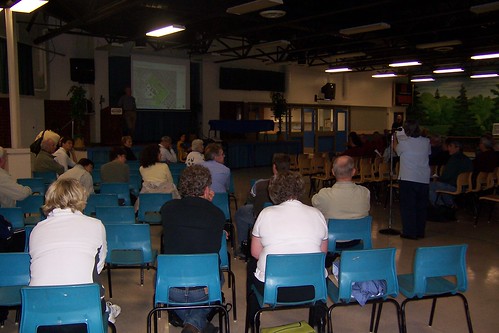
DARTMOUTH – On Monday night, HRM held a public meeting with community members over the master plan to transform the Dartmouth Common [PDF] into a “gateway” to Dartmouth. While the mission statements and overarching goals pointed towards creating places where “we will experience both the commonplace and the ordinary,” the real controversy was over the placement of the new Bus Terminal, currently in the parking lot to the north of the Sportsplex.
Before raising the ire of the many people who attended the meeting and passionately argued over the many places where the new Bus Terminal should go by putting in my own two cents, there’s plenty of other content in the Master Plan to go over whose benefits should be seen as self-evident.
First, there were four plans put forward, the major difference between them being that in the first two plans, the bus terminal runs alongside Nantucket Ave. and in the third and fourth plans, the terminal has been rotated 90 degrees and connects Nantucket to Thistle St. All four master plan options call for the elimination of the majority of the Urban Wilderness part of the Common.
Ignoring master plan option one (p.9 of plan), which is practically identical to option two (p.10) except that it proposes replacing almost all green space north of Thistle (aside from Mt. Herman Cemetery) with an ocean of surface parking, the only radical change proposed would be to put a regulation-sized soccer field where the baseball diamond currently is on the southern side of Thistle.

Options three (p.11) and four (p.12, pictured above) propose far more radical, progressive changes; ones not limited to the well-being of the recreational aspects Common but that concern the entire area and drastically transform the suburban Wyse-Nantucket intersection into a far more urban, downtown streetscape. Both options call for a five or six storey “urban block” to be built at the corner where the Scotiabank is currently located, with storefronts on the ground level and offices up above.
In the question period, someone rightly pointed out that this urban block would potentially take development money away from a struggling downtown Dartmouth at the bottom of Portland St. and only decentralize the city further. While I think that this is in part true, the fact that this Dartmouth Common master plan has a certain momentum to it, and that opportunities to replace parking lots at such crucially located intersections with properly planned dense development don’t come around very often, the urban block idea should be supported. The urban block proposal has far more radical implications for the long-term protection of the Common, which would hugely benefit from the increased usage sure to follow from having a more pedestrian-friendly, mixed-use urban edge.
However, this entails amending the current law preventing any new buildings from going up on Common lands, another relatively contentious issue. There are several reasons why this law should be amended besides the urban block project:
- First, with the proposed expansion on the Sportsplex, additional parking spaces are required by law (a whole other issue that needs to be tackled) that will either mean paving over more green space to create new surface parking, building underground parking (an idea problematic not just because of the cost, but also due to environmental factors) or building a raised parking structure.
- Second, the plan also suggests developing an “outdoor activity pavilion and amphitheatre” where Wyse Rd. meets Windmill Rd,described on page seven of the master plan as an “information pavilion,” which would include a skateboard park, skating rink and outdoor gym and potentially even paddling and cycling equipment.
Other exciting aspects of the plan include connecting the Common with the waterfront property currently owned by CN Rail, putting in bike lanes (hopefully fully separated, p.14-15) on all streets surrounding the Common, turning Nantucket Ave. into a boulevard with pedestrian islands as well as much wider sidewalks, and actually closing Thistle Street to all but pedestrians.

Finally, to address the placement of the bus terminal, during question period many people asked why HRM couldn’t just appropriate land bordering the Common to use, rather than using the only densely forested area of the Common? What was made clear that evening, however, was that the “train has left the station,” said Gordon Smith, a planner at CBCL Limited who ran the meeting. The decision had already been made to use one of the two proposed sites laid out in the master plan options. Whether this was due to cost, political expediency or even time constraints (ie. if it is receiving stimulus funds from the feds or is in dire need of being fixed) is anyone’s guess, but my guess is third since work on the new bus terminal is set to begin as soon as possible.
Given that this is the state of affairs, I think that the option to put the bus terminal running from Thistle to Nantucket would work far better than having it parallel to Nantucket. Diagrams in the master plan as well as planners at the meeting all point out that this layout works better for everyone involved; buses would have a separate entrance and exit to use rather than having to turn around in the terminal; buses would avoid having to drive up Nantucket and therefore cut down on the level of noise created; sight lines from Dartmouth High School would also be unobstructed by the terminal since it would be hidden by the hill which would also act as a sound barrier between the terminal and the school (page 13).

When you take into account the additional proposed features shown on page 12 of the Master plan like a storm-water retention wetland to mitigate runoff from surface parking, the glass atrium that would be attached to the Sportsplex and the placement of the structured parking lot behind the proposed urban block, it seems to me that Option four is by far the best plan.
If you have questions or comments you want to make directly to the planners themselves, contact Holly Richardson at Real Property Planning.
photos by Jake Schabas and maps by Real Property Planning

One comment
Why didn’t anyone talk to the Dartmouth District Minor Baseball Association or even bother to give them a heads up regarding the public meeting. We meet with HRM staff throughout the year & had no idea we are about have ball field taken away.